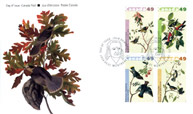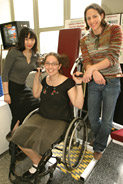Newsbites (Page 2)
Audubon Honoured

It took some doing, but Canada finally got around to issuing a stamp to recognize John James Audubon's visits to this country to capture - at least on paper - 33 bird species in areas that now form Quebec and the Atlantic provinces. These images were later incorporated into Audubon's master work, the four-volume, double-elephant folio Birds of America. ("Double elephant" refers to the extra large pages, approximately 27 by 39 inches, used for printing because Audubon wanted the images to be life-sized.)
In 1861, a group of 100 of Montreal's leading citizens pooled their resources to purchase a set and donated it to McGill. Only 200 sets were produced in the large size, and McGill's is one of five in Canada.
David Lank, a lecturer in the Faculty of Management's Dobson Centre for Entrepreneurial Studies, is also a recognized expert on Audubon and on wildlife art. Lank calls Birds of America "just magnificent" and speculates that it may be "the most valuable book in the world, worth somewhere around $13 million."
It was Lank, author of Audubon's Wilderness Palette, who pressed Canada Post to produce a stamp. To mark the 200th anniversary of Audubon's birth in 1985, 60 countries issued stamps. "Among the exceptions were the five countries - including Canada - with which he was most closely associated," says Lank. Born in Haiti, Audubon was raised in France, then was sent to the U.S. to manage one of his father's properties and avoid conscription into Napoleon's army. His Birds of America was published in the United Kingdom.
It took very little persuading for Canada Post to agree to launch the latest series of stamps - the second of three - at McGill's Redpath Museum. With its stated mandate "to foster the study of the history and diversity of the natural world," Lank says the venerable museum was an easy choice.
Don't Worry, Be Happy
To parents trying to wean their kids off computer games by telling them they're rotting their brains and turning into zombies, the following may be bad news. Experimental psychologist and McGill associate professor Mark Baldwin has surprising results from the research he and a group of McGill doctoral students have been working on. They've developed computer games that can boost self-esteem.
"For people with low self-esteem, negative thought patterns occur automatically and often involuntarily, leading them to selectively focus their attention on failures and rejections," says Baldwin.

The games he and his students have designed boast catchy names such as Wham!, EyeSpy: The Matrix, and Grow Your Chi, and they're built to make people feel more secure. "The three games work by addressing the underlying thought processes that increase self-liking," explains Baldwin. "As athletes know, to learn any new habit takes a lot of practice. Our team wanted to create a new way to help people practise the desired thought patterns to the point of being automatic."
In one game, for example, players are asked to search for a single smiling face in a matrix of 15 frowning faces. Repeating the exercise can train players to focus on positive rather than negative feedback. Another game has players register their name and birthday, which is then paired in the game with smiling, accepting faces. The results are similar to being smiled at by everyone and players take on a more positive attitude about themselves.
All three games were developed by psychology doctoral students Jodene Baccus, Stéphane Dandeneau and Maya Sakellaropoulo, BA'02, under Baldwin's direction.
To test the games and feel good about yourself, visit www.selfesteemgames.mcgill.ca.
Engineering in the Real World

Owen Egan
According to Professor Peter Radziszewski, the Mechanical Engineering Project course - in which final-year students work in teams to design and build real-world mechanical devices - is "the capstone engineering design endeavour" in his department's program. Along with his colleague Professor Rosaire Mongrain, Radziszewski oversees the year-long course and the two must have been feeling proud when their charges unveiled their works recently in the McConnell Engineering Building.
Projects on display ranged from the inner workings of a Baja off-road racecar to an inexpensive prototype designed for removing landmines. Hockey players will be pleased to learn that the annoying vibrations of aluminum hockey sticks can be dramatically reduced by the insertion of a hard foam plug into the stick.
Rui June Sun, Sally Warner and Marie-Luc Arpin (pictured) rejigged a military press machine so that wheelchair-bound exercise enthusiasts could use it to pump iron.
"It's one thing to solve thermodynamic problems as a theoretical exercise," says Warner. "To actually build something like this is a whole new ball game."


